Supply Chains Requirements in a Post-COVID-19 World
Nearly 70% of retail and manufacturing had already begun digital transformation projects before the COVID-19 pandemic, turning the supply chain ecosystem on its head. In a post-COVID-19 world, those digital transformations will likely accelerate, as suppliers and manufacturers turn to always-on IIoT devices to introduce efficiency and flexibility into their industrial processes. The ultimate goal of these changes will be to insulate companies and employees alike from COVID-19-related risks as much as possible.
According to ABI Research, supplier ecosystems of the future will redouble their digitization efforts. However, as warehouses, suppliers, and manufacturing plants ramp up their IIoT solutions, they’re faced with a familiar conundrum: how to power all of these devices. In many industrial settings, long-range wireless power is becoming a key technology to facilitate IIoT growth and success.
The Benefits of IIoT in a Post-Covid World
IIoT devices can make warehouses and factories operate in a more “touchless” manner, protecting workers and securing supply chains from possible COVID-19-related shocks.
Most modern supply chains, for example, rely heavily on sensors. Indeed, roughly 84% of supply chain experts cited sensors as the single most important IIoT device in an industrial setting. Simple sensors can run on battery power and transmit very basic information, such as location. As manufacturers move to more sophisticated IIoT sensors, power requirements increase. But the benefits are significant: integrations and analytics are becoming more useful, predictive, and complex.
A simple sensor on a forklift might keep track of location. But a sophisticated sensor could monitor fuel supply, payload, and maintenance requirements as well. When coordinated with IIoT analytics, forklift use could be prioritized in a way designed to facilitate social distancing. IIoT devices that are 5G-capable can return that information more quickly and lead to an improved ability to make comprehensive real-time decisions based on data.
The Problem With IIoT at Scale
To install one battery-operated sensor is no big deal. Eventually, the batteries will run out and will require replacement–an easy enough task for a single individual. But when applied at scale, battery-operated IIoT becomes quite challenging. Changing thousands of batteries simply isn’t feasible. Likewise, tethering all of those devices to a stationary power source limits device effectiveness and flexibility.
As a result, IIoT has seen slow adoption in some manufacturing and supply chain ecosystems, especially because more sophisticated devices require greater energy. Without an always-on innovation, this means that the most useful devices are also the least feasible.
Always-On Solutions for IIoT Energy Requirements
In order to incorporate useful IIoT devices, many supply chain managers and manufacturers have turned to various always-on energy solutions. These solutions include:
- Solar energy: In some cases, small solar panels are attached to the devices in question. The idea is that under the harsh and bright factory floor lights, the device would receive enough energy to function at high levels. While solar energy panels have been a popular choice, they haven’t always been able to provide the necessary power to run IIoT devices. A 4-inch by 4-inch solar panel, for instance, is a popular size but can only produce roughly 1 milliwatt of power when it is lit. For always-on power demands, that’s only a minimal contribution.
- Long-range wireless charging: A new alternative to solar energy, long-range wireless charging provides a continuous charge wirelessly over a long distance. The transmitting device is roughly the size of a Nest thermostat, and the receiver is roughly the size of a USB stick. The receiving panel is plugged into the customer’s device of choice with a USB connector. Once plugged in, the device receives a constant stream of power over dozens of meters. The delivered power can be up to about 1 Watt, about 1000 times more than a solar panel yet with a much smaller physical footprint.
How Wireless Charging Enables a Touchless Future
A post COVID-19 world will by necessity mean a more touchless working environment. Not only will the day-to-day tasks of manufacturers and supply chain managers enter a less hands-on era, but so too will all peripheral devices. By embracing IIoT technology, factory and warehouse managers can:
- Monitor the health of the supply chain remotely: Sensors and software can combine to ensure any issues in the supply chain can be detected and resolved as early as possible. This can cut down on the amount of on-the-ground maintenance personnel needed at any given site.
- Create touchless sanitation: Any employees who are working within a factory setting will likely need increased access to handwashing and sanitation stations. As a result, site managers will need to invest in touchless washing devices. Wireless charging can help make those stations as mobile and flexible as possible. IIoT technology means site managers can even monitor the maintenance needs of sanitation devices, such as soap or paper towel supply levels.
- Real-time responsiveness: The most sophisticated IIoT devices are able to receive and transmit a massive amount of data, especially when they’re enabled by wireless charging. This means supply chains will be able to remain flexible while maximizing efficiency. Managers will be able to make decisions based on real-time data. And long-range wireless charging means that data will be more accurate, responsive, and reliable.
The Digitization Transformation is More Important Than Ever
The COVID-19 pandemic has expedited the adoption of many digital IIoT technologies. That’s forcing many in industrial settings–especially manufacturing and supply chain management–to adapt quickly. That can be painful in the short run.
But in the long run, powered by wireless charging, IIoT will make manufacturing and supply chain management more efficient, flexible, and profitable, while simultaneously keeping employees safer and happier. Always-on power is the key that’s been missing, and given today’s current climate, it’s more welcome than ever before.
Author
Yuval Boger![]() is the CMO of Wi-Charge, the world leader in long-range wireless power. Yuval is an expert on wireless power technology and has experience working with large hotel chains on technology on implementing this technology. Yuval holds an MBA from the Kellogg school at Northwestern University and a M.Sc. in Physics from Tel-Aviv University.
is the CMO of Wi-Charge, the world leader in long-range wireless power. Yuval is an expert on wireless power technology and has experience working with large hotel chains on technology on implementing this technology. Yuval holds an MBA from the Kellogg school at Northwestern University and a M.Sc. in Physics from Tel-Aviv University.
Sorry, the comment form is closed at this time.




Pingback: Supply Chains Requirements in a Post-COVID-19 World – IoT – Internet of Things
Pingback: Supply Chains Requirements in a Post-COVID-19 World | Wirandle By Ọ L Á Y Ẹ M Í | Reporting Technology News